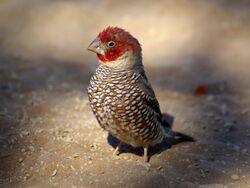Biology:Red-headed finch
| Red-headed finch | |
|---|---|

| |
| male | |
| Scientific classification | |
| Domain: | Eukaryota |
| Kingdom: | Animalia |
| Phylum: | Chordata |
| Class: | Aves |
| Order: | Passeriformes |
| Family: | Estrildidae |
| Genus: | Amadina |
| Species: | A. erythrocephala
|
| Binomial name | |
| Amadina erythrocephala | |
The red-headed finch (Amadina erythrocephala) (also known as the paradise finch) is a common species of estrildid finch found in Africa. It has an estimated global extent of occurrence of 1,600,000 km2. It is found in Angola, Botswana, Lesotho, Namibia, South Africa and Zimbabwe.
Males have vibrant red heads and chests while the females are duller. The resemblance to the cut-throat finch is unmistakable. The red-headed and cut-throat finch are the only members of the genus Amadina. Amadinas with their heavy beaks resemble members of the Lonchura, so they are actually more closely related to the Pytilias such as the Melba finch.[2]
Taxonomy
The red-headed finch was formally described by the Swedish naturalist Carl Linnaeus in 1758 in the tenth edition of his Systema Naturae under the binomial name Loxia eryocephala, a misspelling of Loxia erythrocephala.[3][4] The specific epithet combines the Ancient Greek eruthros meaning "red" with -kephalos meaning "headed".[5] Linnaeus based his description on "The Sparrow of Paradise" that had been described and illustrated in 1751 by the English naturalist George Edwards in his A Natural History of Uncommon Birds. Edwards' specimen had been collected in Angola.[6] This species is now placed with the cut-throat finch in the genus Amadina that was introduced in 1827 by the English naturalist William John Swainson.[7][8] The species is monotypic: no subspecies are recognised.[8]
Behaviour
Often seen in small flocks on dry savannahs, the red-headed finch is a ground feeder which feeds companionably with other species and often visits waterholes. It has a distinctive double-noted chuck-chuck call.[9]
References
- ↑ BirdLife International (2016). "Amadina erythrocephala". IUCN Red List of Threatened Species 2016: e.T22719932A94652129. doi:10.2305/IUCN.UK.2016-3.RLTS.T22719932A94652129.en. https://www.iucnredlist.org/species/22719932/94652129. Retrieved 12 November 2021.
- ↑ "The Red Head Finch - Amadina erythrocephala". http://www.efinch.com/species/redhead.htm.
- ↑ Linnaeus, Carl (1758) (in Latin). Systema Naturae per regna tria naturae, secundum classes, ordines, genera, species, cum characteribus, differentiis, synonymis, locis. 1 (10th ed.). Holmiae (Stockholm): Laurentii Salvii. p. 172. https://www.biodiversitylibrary.org/page/727079.
- ↑ Paynter, Raymond A. Jr, ed (1968). Check-List of Birds of the World. 14. Cambridge, Massachusetts: Museum of Comparative Zoology. p. 388. https://www.biodiversitylibrary.org/page/14481589.
- ↑ Jobling, James A. (2010). The Helm Dictionary of Scientific Bird Names. London: Christopher Helm. p. 149. ISBN 978-1-4081-2501-4.
- ↑ Edwards, George (1751). A Natural History of Uncommon Birds. Part IV. London: Printed for the author at the College of Physicians. p. 180. https://www.biodiversitylibrary.org/page/50196434.
- ↑ Swainson, William John (1827). "On several groups and forms in ornithology, not hitherto defined". Zoological Journal 3: 343–363 [349]. https://www.biodiversitylibrary.org/page/27485875.
- ↑ 8.0 8.1 Gill, Frank; Donsker, David; Rasmussen, Pamela, eds (January 2021). "Waxbills, parrotfinches, munias, whydahs, Olive Warbler, accentors, pipits". IOC World Bird List Version 11.1. International Ornithologists' Union. https://www.worldbirdnames.org/bow/waxbills/. Retrieved 10 July 2021.
- ↑ Newman, K. Newman's Birds of Southern Africa. ISBN:1-86812-278-6. p. 428.
- Newman, K. Newman's Birds of Southern Africa. ISBN:1-86812-278-6. p. 428.
External links
- Species factsheet - BirdLife International
- Breeding information - eFinch
- Species text - The Atlas of Southern African Birds
- Distribution map - Biodiversity explorer shows a distribution map
Wikidata ☰ Q641416 entry
 |


